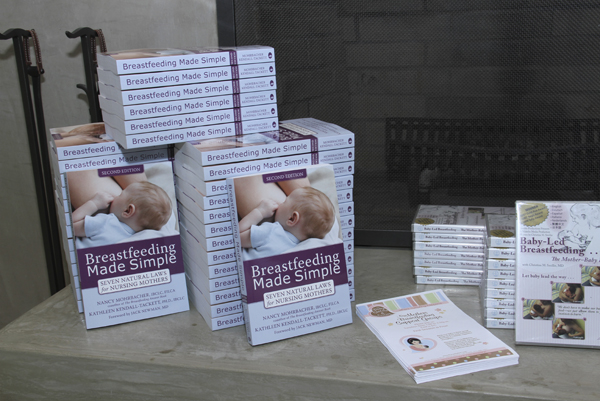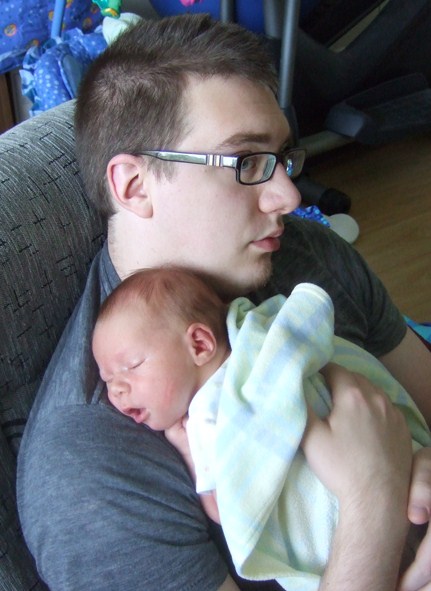Almost any woman can induce lactation through breast stimulation with a breast pump or by just putting a baby to the breast to suckle. The hormones cause the milk ducts to start making milk. Mothers often question how much they will produce. But the amount of milk I made is not what was important to me. I April and Andrewknew I would adopt a baby older than 12 months, so this did not concern me as much as it would if my child had been an infant.
I had heard about adoptive breastfeeding for years, but since I was adopting an older baby, I assumed it wasn’t possible. I had already grieved the loss of having children by birth and had come to terms with never having a breastfeeding relationship with my children. This was okay with me. Then one day in an adoption search I saw a story about a wonderful breastfeeding relationship between a mother and baby who was adopted at about 2 years of age. I thought, “You have to be kidding me! How is this possible? What about the ‘nipple confusion’ I had heard so much about? How do you teach them to do it? And what impact does that have on their mind and soul? How would my friends and family react?” This would certainly be a strange thing to do. It turned out my friends and family were happy and supportive. And breastfeeding my adopted baby felt completely natural. Many mothers find this a wonderful way to bond with their adopted children.
I decided to try inducing lactation, and started by pumping 5 to 8 times a day for about 10 minutes. The first day I only produced a few golden yellow drops. The next day I saw white milk but did not make much. At the end of 3 months I was only pumping about 1 to 2 ounces (30 to 60 mL) a day. It may sound crazy that I was pumping so much and getting so little milk. I kept reminding myself that getting a lot of milk was not my goal. I was preparing my breasts for suckling and stimulating milk for my baby. I was excited that my breasts were making any milk at all and amazed this was possible!
Then one day we got the call and went to pick up our children: two brothers 20 months and 3 years old. They told us my 20-month-old was not taking a bottle, but I had already purchased some bottles in preparation, so I thought I would try re-introducing it to him. I was unsure if he would want to breastfeed, but we would try and if he decided not to, that would be okay.
He loved the bottles of milk! They were one of the few things that comforted him at first. His hands held the bottle tightly as if someone was going to take it away. During the first few days, my son would not let me touch him. He only wanted to be held by my husband, who he gave him the bottles. This was heartbreaking after all my preparation, but I was also prepared for this and didn’t take it as a rejection. I knew he would come around. The first two nights he was up almost all night. The bottle would put him to sleep, but taking the nipple out of his mouth woke him. Moving him woke him and he woke within an hour of sleeping. He was scared and in a strange house with strangers all around. How in the world was breastfeeding ever going to work? He wouldn’t even let me hold him.
After a few days, I decided to sleep with him on the kitchen floor so I could get the bottles fast and my husband could sleep. My son still woke screaming. The bottles helped, but they didn’t always work. Then we decided only I would give him food and all bottles would come while I held him in my arms. This meant no high chair at dinner, no snacks he could hold himself, and no bottles while walking around. When he took a bottle, he wouldn’t look at us. He wouldn’t let me touch the bottle. I think he was scared someone would take it away. He wanted to keep the nipple in his mouth even in his sleep. This was a good sign he would like breastfeeding once we got there.
I did everything I could to get close to him during the first few weeks, rocking, walking with him, holding, co-bathing, co-sleeping. Any kind of skin-to-skin contact did us good. At first my 20-month-old wouldn’t let me put my hand on him while sleeping. He would wake up immediately and push my hand away, because he was used to sleeping in a crib all by himself. Within the first week, he let me put my hand on him for short times. I tried to stay close to him all day while he played and put my hand on him whenever he would let me. We still had moments when he would scream and cry, run away, and want me to leave the room. He would cry for hours. But it was expected and normal for him to be upset and mad that his whole world had been turned upside down. These moments always ended with him finally taking a bottle with me and going to sleep. We were getting closer, and he was getting to know that he could trust me, but it was slow going. I was up almost all night long but loved every minute of it. I remember one day sending an e-mail to my mom and sister at 5:00 am telling them that I hadn’t slept but that I was crying because I was so delirious with happiness. It had been one of the good nights when we played and laughed and cuddled and rocked with bottles with only a few bad episodes. It was getting better every night!
I also talked to both of my kids about mommies and babies nursing. We would have the baby ducks nurse from their mommies in the bathtub. We would read books that had animals nursing. Both of my kids loved to play with their animals and dolls and to nurse them. This was a good way for my 3-year-old to learn how a mommy is supposed to take good care of her children.
After about 2 weeks, my 20-month-old finally started waking up looking for me, happy to see me instead of screaming. I put my hand on him more and more while he slept to get him used to the feeling of a warm body near him. One time he woke up, saw I was there, and went back to sleep. When giving him bottles in my arms, he started to let me hold him while lying down. The bottle still faced slightly away from me, but he could look at me now. I starting taking off our shirts for more skin-to-skin contact, and also so his face was next to my breast and he could feel and smell it. He still held the bottle really tight and wouldn’t let me hold it, so it was difficult to take it from him after he fell asleep. I started wrapping the bottle in a big piece of soft material to give him something soft to hold onto but not to look at while the milk flowed. This worked. When he fell asleep, his hands fell gently away from the material.
During the third week, I began put the tube of an at-breast supplementer next to the bottle nipple. I planned to put this tube next to my nipple while breastfeeding so he could get more milk at the breast. He needed to get used to that idea, so I pulled the tube through the bottle nipple with a needle, and then filled the supplementer bag with milk. Now the bottom of the bottle was no longer needed and the material hid the fact it was missing. I thought the slower flow of the supplementer might create anxiety, but he didn’t seem to notice the difference.
He was now used to sitting down with me for milk and began pointing to the refrigerator when he wanted some. He also started playing with my face and hair and laughing while drinking. Occasionally he wanted to sit and drink milk if he was upset or hurt.
At the end of the third week I put the bottle nipple closer to my breast and then right over my breast. Then I could move him toward me into a breastfeeding position. We were almost breastfeeding even though he had not yet latched on. He got milk from me while being held in my arms. He felt my skin next to his belly. He felt my breast against his cheek. He looked into my eyes. He smiled back at me. He got to know my smell and trusted that I would comfort him and give him nourishment when he needed it. He played with my other breast with his hand and my hair, nose, eyes, and mouth. He put his leg up so I would play with his foot and make him laugh. He fell asleep while rocking in my arms. This is what breastfeeding is all about! If we stayed like this forever, and never actually breastfed, I would still be in heaven!
During the fourth week he was really happy and content, so I decided to offer my breast with the supplementer tube next to it. It felt different. He was confused and didn’t want it. But when he was asleep, I tried offering my breast and he took it, sucking for about 5 minutes. Hurray! And wow, what a strange feeling. This was certainly different than the pumping I had done for 4 months. We were breastfeeding, even if it was only in his sleep.
Then there were a couple of bad days. He woke screaming again in the middle of the night and didn’t want the bottle nipple with the tube. He pushed both my husband and me away and wanted to cry by himself. This gave me doubts. Maybe all these changes happened too fast, so I didn’t offer my breast again for 3 or 4 days. After a few days of this, he was happy with the bottle nipple and tube again and awoke happy to see me. I decided this probably had more to do with his grieving process than with breastfeeding.






























